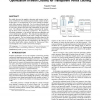Free Online Productivity Tools
i2Speak
i2Symbol
i2OCR
iTex2Img
iWeb2Print
iWeb2Shot
i2Type
iPdf2Split
iPdf2Merge
i2Bopomofo
i2Arabic
i2Style
i2Image
i2PDF
iLatex2Rtf
Sci2ools
SIGGRAPH
1999
ACM
1999
ACM
Optimization of Mesh Locality for Transparent Vertex Caching
Bus traffic between the graphics subsystem and memory can become a bottleneck when rendering geometrically complex meshes. In this paper, we investigate the use of vertex caching to transparently reduce geometry bandwidth. Use of an indexed triangle strip representation permits application programs to animate the meshes at video rates, and provides backward compatibility on legacy hardware. The efficiency of vertex caching is maximized by reordering the faces in the mesh during a preprocess. We present two reordering techniques, a fast greedy strip-growing algorithm and a local optimization algorithm. The strip-growing algorithm performs lookahead simulations of the cache to adapt strip lengths to the cache capacity. The local optimization algorithm improves this initial result by exploring a set of perturbations to the face ordering. The resulting cache miss rates are comparable to the efficiency of the earlier mesh buffer scheme described by Deering and Chow, even though the vert...
Computer Graphics | Local Optimization Algorithm | SIGGRAPH 1999 | Strip-growing Algorithm | Vertex Caching |
| Added | 03 Aug 2010 |
| Updated | 03 Aug 2010 |
| Type | Conference |
| Year | 1999 |
| Where | SIGGRAPH |
| Authors | Hugues Hoppe |
Comments (0)

